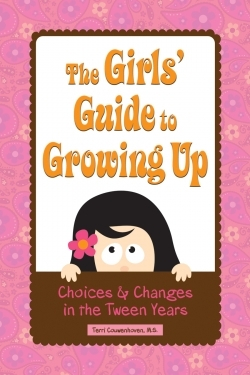The Girls' Guide to Growing Up
Choices and Changes in the Tween Years
Whether you are ready for it or not, your daughter will grow up. She will have questions about the process and, as a parent, you will need to have answers. Terri Couwenhoven, M.S., a certified sexuality educator who specializes in helping children with intellectual disabilities, has made it easier to answer these questions in The Girls’ Guide to Growing Up: Choices & Changes in the Tween Years.
A tween is defined as a pre-teen and includes children from ages eight to twelve. Geared toward girls with intellectual disabilities, the book is concise, easy to read and understand, and employs straight-to-the-point language. Chapter topics in this well-organized, slim volume include “Puberty Basics,” “Outside Changes,” “Inside Changes,” Periods,” “Caring for Your Body,” and “Public or Private.” Each section gives a thorough overview of all of the changes that will happen to a tween during the onset of puberty.
For example, in the section called “Changes in Your Growth,” the author explains: “During puberty your body will grow in many ways! You will get taller and you will need larger clothes. Your feet will grow and you will need bigger shoes. Your hips will get rounder, curvier, and not so straight. These body changes are normal. They happen to all girls during puberty. It will take a few years for your body to stop growing and changing. When puberty is over, you will look like a woman.”
The book also sensitively deals with all-too-often “taboo” topics, such as burgeoning sexual feelings, which body parts are public and which are private, and what a child should do if she is touched inappropriately. Mood swings and changes in hair, skin, and breast development are other highlighted subjects. Common questions and answers about menstrual periods are provided at the end of the book.
Helpful graphics, illustrations, and black-and-white photographs accompany much of the text. Some of the language is repetitive, intentionally so, to help make it easier for girls with intellectual disabilities to process.
The book would not be appropriate for any other audience, as the language and concepts would likely be seen as too basic in the way it imparts information, but for its intended readers, it is an on-target vehicle for sharing a discussion about these delicate topics.
Reviewed by
Hilary Daninhirsch
Disclosure: This article is not an endorsement, but a review. The publisher of this book provided free copies of the book and paid a small fee to have their book reviewed by a professional reviewer. Foreword Reviews and Clarion Reviews make no guarantee that the publisher will receive a positive review. Foreword Magazine, Inc. is disclosing this in accordance with the Federal Trade Commission’s 16 CFR, Part 255.

